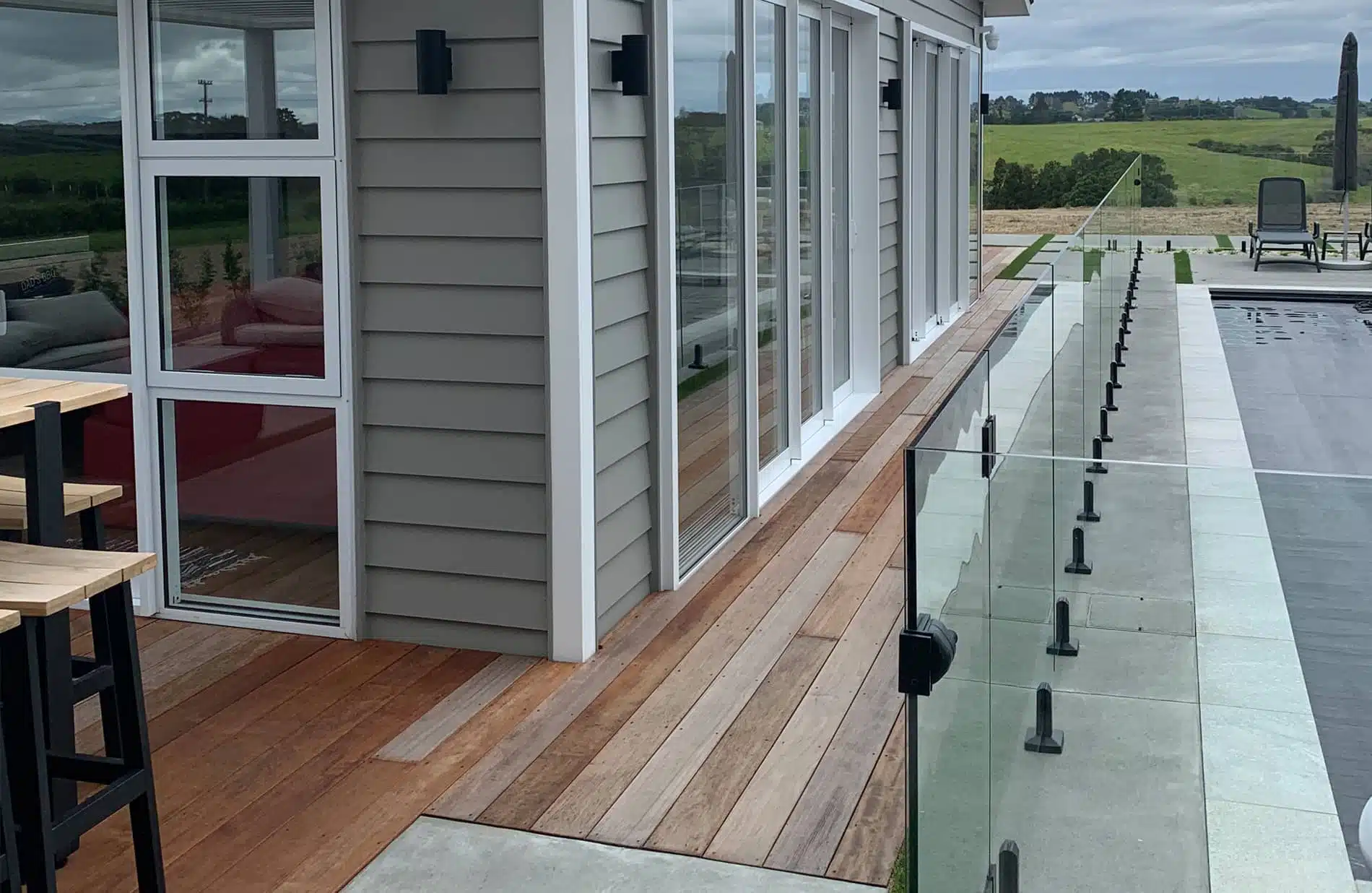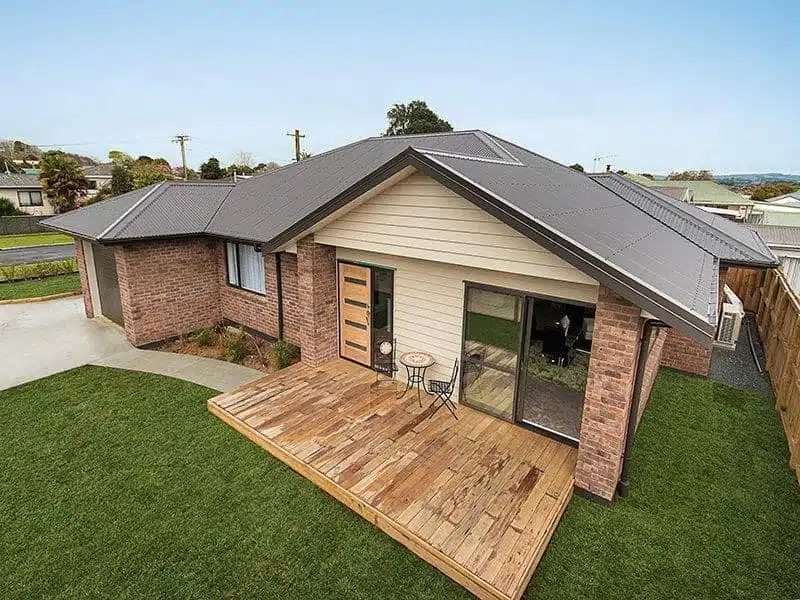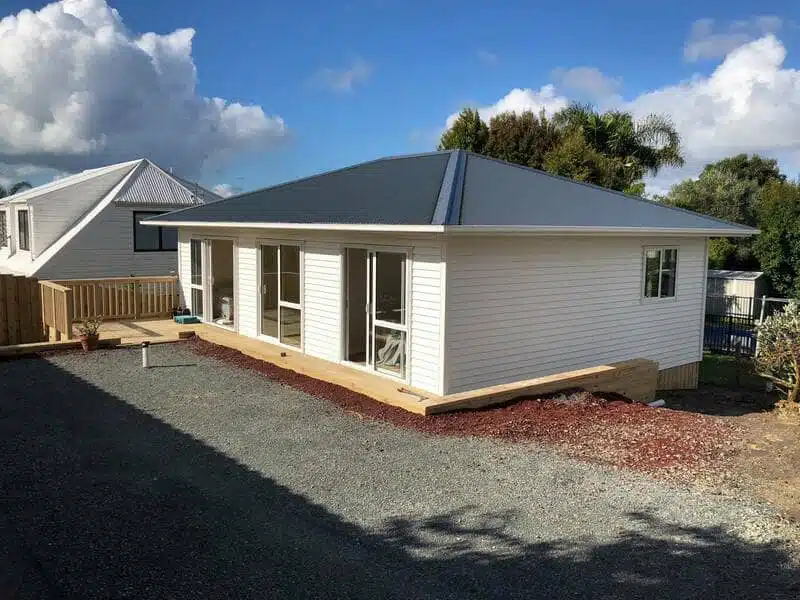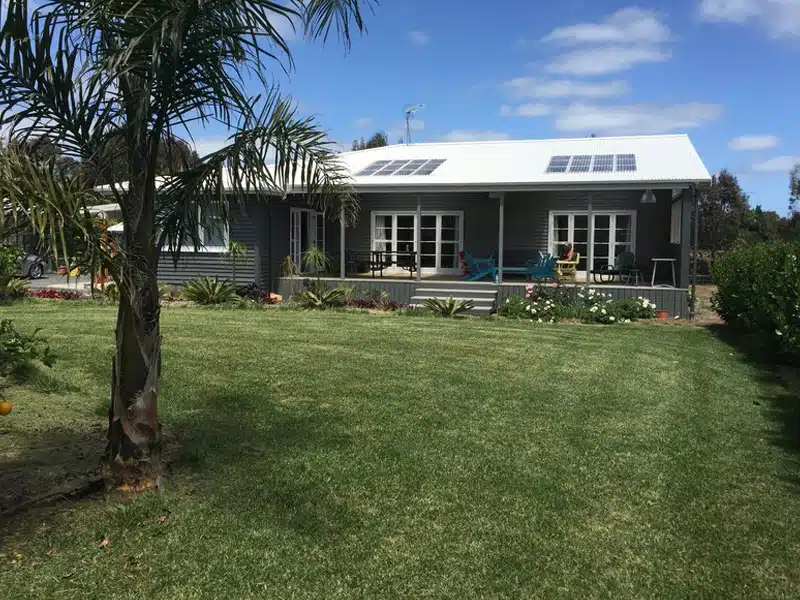
Building a new home is an exciting and life-changing experience, but it can also be overwhelming without proper guidance. The new build home process involves numerous steps, decisions, and potential pitfalls that can make the journey seem daunting. That’s why we’ve created this ultimate new build guide to help you navigate the process of building a new home in Franklin, New Zealand.
This comprehensive guide will provide you with a step-by-step process to build a house, ensuring that you have all the information you need to make informed decisions and avoid common mistakes. Whether you’re a first-time homebuyer or an experienced property owner, understanding the building a new home process is crucial to achieving your dream home.
Throughout this guide, we’ll cover essential topics such as planning your new home, selecting the right builder, understanding the pre-construction and construction phases, and navigating the buying process. We’ll also introduce you to Rag Reno’s, a trusted home builder in Franklin, New Zealand, known for high-quality, personalized homes and exceptional customer service.
By the end of this guide, you’ll have a clear understanding of the new build home process and feel confident in your ability to make informed decisions throughout your homebuilding journey. So, let’s dive in and explore the exciting world of building a new home in Franklin, New Zealand!
Overview of the new build process
- Planning: This stage involves determining your budget, exploring financing options, choosing a location, and selecting a builder. You’ll also work on designing your home layout and features.
- Pre-Construction: During this phase, you’ll obtain necessary permits and approvals, prepare the building site, finalise construction plans and contracts, and ask important questions about the buying process.
- Construction: This is when your dream home begins to take shape. The construction process includes foundation and framing, roofing, windows, doors, electrical, plumbing, HVAC systems, insulation, drywall, flooring, painting, and finishing touches.
- Buying: As the construction progresses, you’ll navigate the process of buying a new build home, which involves understanding the pros and cons, negotiating with builders and sales representatives, and familiarizing yourself with warranties and maintenance responsibilities.
- Moving In and Settling Down: Once construction is complete, you’ll perform final inspections, close the sale, and take ownership of your new home. From there, you’ll move in and begin maintaining your newly built home.
Building a new home is a significant milestone, and having a clear understanding of the process can help you approach each stage with confidence. This guide aims to provide you with the knowledge and tools necessary to make informed decisions throughout your homebuilding journey.
Importance of a step-by-step guide to build a house
That’s where a step-by-step process to build a house comes in handy. Here are some reasons why a comprehensive guide is essential:
- Clarity and Organization: A well-structured guide breaks down the new build home process into manageable stages, providing a clear roadmap for your homebuilding journey. This clarity helps you stay organized and focused throughout the process.
- Informed Decision-Making: A step-by-step guide provides valuable information on each stage of the process, enabling you to make informed decisions about your new home. From budgeting and design to selecting a builder and navigating contracts, a comprehensive guide empowers you to make choices that align with your goals and preferences.
- Time and Cost Savings: By following a step-by-step guide, you can avoid costly mistakes and delays that often result from a lack of knowledge or planning. A guide helps you anticipate potential issues and provides strategies for addressing them proactively, ultimately saving you time and money.
- Stress Reduction: Building a new home can be stressful, especially if you’re unsure about what to expect at each stage. A step-by-step guide demystifies the process, providing peace of mind and reducing stress levels. With a clear understanding of what lies ahead, you can approach each stage with confidence and excitement.
- Effective Communication: A comprehensive guide equips you with the knowledge and vocabulary necessary to communicate effectively with builders, contractors, and other professionals involved in your new build home process. This enhanced communication helps ensure that your vision for your dream home is clearly understood and executed.
Investing time in understanding the step-by-step process of building a house is crucial for a successful and enjoyable homebuilding experience.
By leveraging the information provided in a comprehensive guide, you can navigate the new build home process with confidence, making informed decisions and bringing your dream home to life.
Planning Your New Home
Determining your budget and financing options
- Income and Expenses: Assess your current income and expenses to determine how much you can realistically allocate towards your new home. Factor in potential changes to your income or expenses soon.
- Savings and Assets: Evaluate your savings and assets, including any funds you’ve specifically set aside for your new home. Consider how much of these resources you’re willing to invest in your homebuilding project.
- Financing Options: Research various financing options, such as mortgages, construction loans, and government grants. Compare interest rates, loan terms, and eligibility requirements to find the most suitable option for your needs.
- Additional Costs: Remember to account for additional costs beyond the construction itself, such as land purchase, permits, taxes, and interior finishings. Factor these expenses into your overall budget to avoid surprises later on.
Once you have a clear picture of your budget and financing options, you can make informed decisions about the size, style, and features of your new home. It’s essential to be realistic about your budget and prioritize your needs and wants accordingly.
WANT AN INSTANT ESTIMATE FOR YOUR PROJECT?
Choosing the right location in Franklin, New Zealand
- Lifestyle and Preferences: Think about your lifestyle and preferences, such as proximity to work, schools, shopping, and recreational activities. Consider whether you prefer a more urban, suburban, or rural setting.
- Future Development: Research the potential for future development in the area, including infrastructure projects, community plans, and zoning changes. This information can help you anticipate how the location may evolve over time.
- Property Value: Investigate property values in different areas of Franklin, and consider the potential for appreciation over time. Working with a local real estate agent or appraiser can provide valuable insights into market trends.
- Natural Hazards: Be aware of any natural hazards, such as flood zones or earthquake-prone areas, that may affect your chosen location. Understanding these risks can help you make an informed decision and plan accordingly.
- Community and Culture: Explore the community and culture of different neighbourhoods in Franklin. Consider factors such as demographics, safety, and community events to find a location that aligns with your values and lifestyle.
By carefully considering these factors and doing your due diligence, you can select a location in Franklin, New Zealand, that not only meets your practical needs but also feels like home.
Choosing the right location in Franklin, New Zealand
-
Qualities to look for in a builder
a. Experience and expertise:
Look for a builder with a proven track record of successfully completing projects similar to yours. They should have expertise in the type of home you want to build and be knowledgeable about local building codes and regulations.
b. Reputation and references:
Research the builder’s reputation by reading online reviews, checking their rating with the Better Business Bureau, and asking for references from past clients. A reputable builder will be happy to provide references and examples of their work.
c. Communication and transparency:
Choose a builder who communicates clearly and transparently throughout the process. They should be responsive to your questions and concerns and keep you informed about progress, timeline, and any issues that arise.
d. Licensing and insurance:
Ensure that the builder is properly licensed and insured. This protects you from liability in case of accidents or damage during construction and ensures that the builder adheres to industry standards and regulations.
-
Questions to ask potential builders
a. What is your experience with projects similar to mine?
Ask about their experience with homes of similar size, style, and complexity to yours. This will give you a sense of their ability to handle your specific project.
b. Can you provide references from past clients?
Request references from past clients and follow up with them to learn about their experience working with the builder. Ask about the builder’s communication, timeliness, and quality of work.
c. How do you handle changes or unexpected issues during construction?
Inquire about the builder’s process for managing change orders and addressing unexpected issues that may arise during construction. A good builder will have a clear and fair process in place.
d. What warranties or guarantees do you offer?
Ask about the warranties or guarantees the builder offers on their work. A reputable builder will stand behind their work and offer reasonable warranties to protect your investment.
-
Red flags to watch out for
a. Lack of proper licensing or insurance:
Be wary of builders who cannot provide proof of proper licensing or insurance. This may indicate a lack of professionalism or adherence to industry standards.
b. Reluctance to provide references or portfolio:
If a builder is hesitant to provide references or examples of their work, it may be a sign that they have something to hide or lack confidence in their abilities.
c. Pressure to make quick decisions or sign contracts:
Be cautious of builders who pressure you to make hasty decisions or sign contracts without allowing you sufficient time to review and understand the terms. A reputable builder will respect your need to make informed decisions at your own pace.
d. Unusually low bids or vague pricing:
If a builder’s bid is significantly lower than others or their pricing is vague or unclear, it may be a red flag. Unusually low bids may indicate that the builder is cutting corners or using subpar materials, while vague pricing may lead to unexpected costs down the line.

Designing your new home layout and features
-
Functionality and Flow:
Think about how you and your family will use the space and design a layout that promotes ease of movement and functionality. Consider the placement of rooms, storage, and amenities to ensure a smooth flow throughout the home.
-
Lifestyle and Future Needs:
Design your home with your current lifestyle and future needs in mind. Consider factors such as family size, work arrangements, hobbies, and potential life changes, such as aging in place or accommodating a growing family.
-
Energy Efficiency and Sustainability:
Incorporate energy-efficient features and sustainable materials into your home design to reduce your environmental impact and save on utility costs in the long run. Consider options such as solar panels, energy-efficient appliances, and water-saving fixtures.
-
Personal Style and Aesthetics:
Infuse your personal style and aesthetics into your home design through the selection of colours, materials, finishes, and architectural elements. Create a cohesive and visually appealing space that reflects your unique taste and personality.
-
Budget and Priorities:
Balance your design wishes with your budget and prioritize the features and elements that are most important to you. Be willing to make trade-offs and compromises to ensure that your home design aligns with your financial capabilities.
Designing your new home layout and features is a collaborative process that involves working closely with your builder and design professionals. Be open to their expertise and suggestions while advocating for your vision and needs.
Rag Reno's: Your Trusted Home Builder in Franklin, New Zealand
A. About Rag Reno’s and our history in the Franklin community
At Rag Reno’s, we have been proudly serving the Franklin community for over a decade. Founded by John, a skilled builder with a passion for crafting beautiful and functional homes, our company has grown from a small, family-run business to a trusted name in the local construction industry.
Throughout our history, we have remained committed to our core values of quality, integrity, and personalized service.
B. Our approach to building high-quality, personalized homes
We believe that building a home is not just about bricks and mortar; it’s about creating a space that reflects your unique lifestyle, tastes, and dreams. That’s why we take a personalized approach to every project, working closely with our clients to understand their needs, preferences, and budget.
From the initial consultation to the final walk-through, we are dedicated to ensuring that your new home exceeds your expectations.
Our team of experienced professionals combines traditional craftsmanship with the latest building techniques and materials to create homes that are not only beautiful but also durable, energy-efficient, and built to last.
We are committed to using high-quality materials and working with trusted suppliers to ensure that your home is constructed to the highest standards.
C. Services offered by Rag Reno’s
At Rag Reno’s, we offer a range of services to meet the diverse needs of our clients in Franklin, New Zealand. Our main services include:
- New builds: We specialize in building custom homes tailored to your unique specifications. From modern and sleek to traditional and timeless, we can bring your vision to life.
- Renovations: Whether you’re looking to update a single room or transform your entire home, our skilled team can handle projects of any size and complexity.
- Villa renovations: We have extensive experience in renovating and restoring the charming villas that are a hallmark of Franklin’s architectural heritage. We work to preserve the character of these historic homes while updating them with modern amenities and functionality.
D. Why choose Rag Reno’s for your new home build
Choosing the right builder is one of the most important decisions you’ll make in your new build home process. Here are some reasons why Rag Reno’s is the trusted choice for homebuyers in Franklin, New Zealand:
- Local expertise: As a locally owned and operated business, we have deep roots in the Franklin community and a strong understanding of the unique challenges and opportunities of building in this area.
- Personalized service: We believe in building relationships, not just homes. We take the time to understand your needs, preferences, and budget, and we work closely with you throughout the process to ensure your satisfaction.
- Quality craftsmanship: Our team of skilled professionals is committed to delivering the highest quality craftsmanship, using the best materials and techniques to create homes that are built to last.
- Transparency and communication: We believe in open, honest communication and transparency throughout the building process. We keep you informed every step of the way and are always available to answer your questions and address your concerns.
- Customer satisfaction: Our ultimate goal is your satisfaction, and we go above and beyond to ensure that your experience with Rag Reno’s is positive and stress-free.
When you choose Rag Reno’s as your home builder, you can trust that you are in capable hands. We are committed to helping you navigate the new build home process with confidence and ease, and we look forward to bringing your dream home to life.
Pre-Construction Phase
A. Obtaining necessary permits and approvals
Before any construction can begin, you’ll need to obtain the necessary permits and approvals from your local council and building authorities. This process ensures that your new home complies with local building codes, zoning regulations, and safety standards.
Your builder should be well-versed in the permit application process and can guide you through the requirements specific to your location in Franklin, New Zealand.
B. Preparing the building site
Site preparation is a crucial step in the pre-construction phase. This involves clearing the land, excavating for the foundation, and ensuring that the site is properly graded and ready for construction.
Your builder will coordinate with earthworks contractors to prepare the site according to your home design and the specific characteristics of your land, such as soil type and drainage requirements.
C. Finalizing construction plans and contracts
Before construction begins, you’ll need to finalize your construction plans and contracts with your builder. This involves reviewing and approving detailed blueprints, specifications, and material selections to ensure that everything aligns with your vision and budget.
Your builder will provide you with a comprehensive contract that outlines the scope of work, timeline, payment schedule, and any warranties or guarantees.
It’s essential to carefully review and understand all aspects of your construction plans and contracts before signing. Don’t hesitate to ask questions or seek clarification from your builder on any points that are unclear.
A reputable builder will be transparent and willing to address any concerns you may have.
D. Questions to ask when buying a new build home
When buying a newly built home, it’s important to ask the right questions to ensure that you make an informed decision. Here are some key questions to consider:
- What is included in the base price, and what are the potential additional costs?
- What are the standard features and finishes, and what options are available for upgrades?
- What is the estimated completion date, and what happens if there are delays?
- What warranties or guarantees are provided for the home and its systems?
- How does the builder handle changes or modifications during the construction process?
- What is the builder’s policy on inspections and walk-throughs during construction?
- What is the builder’s after-sales service and support policy?
By asking these questions and carefully considering the answers, you can gain a better understanding of what to expect when buying a newly built home and make a more informed decision.
The pre-construction phase is a critical stage in the new build home process that sets the stage for a successful construction experience. By obtaining the necessary permits, preparing the site, finalizing plans and contracts, and asking the right questions, you can ensure that your new home build gets off to a strong start.

Construction Process
Understanding what happens at each stage can help you better appreciate the craftsmanship and expertise that goes into building a high-quality home.
A. Foundation and framing
The construction process begins with laying the foundation of your home. This involves pouring concrete footings and walls or installing a concrete slab, depending on your home design and site conditions.
Once the foundation is set, the framing of your home begins. This stage involves constructing the skeletal structure of your home using lumber or steel, including the walls, floors, and roof trusses.
Framing is a critical stage that sets the stage for the rest of the construction process and ensures the structural integrity of your home.
B. Roofing, windows, and doors
With the framing complete, the next step is to install the roof, windows, and doors. The roof protects your home from the elements and plays a significant role in its overall energy efficiency.
Windows and doors are installed to provide natural light, ventilation, and access to your home. This stage also involves installing any skylights or special window features you may have selected.
C. Electrical, plumbing, and HVAC systems
As the construction of your home progresses, the focus shifts to installing the essential systems that make your home functional and comfortable. This includes the electrical system, which provides power to your home’s lighting, appliances, and outlets.
The plumbing system is installed to supply water and remove waste, while the heating, ventilation, and air conditioning (HVAC) system regulates your home’s temperature and air quality. These systems are typically installed before the insulation and drywall are put in place.
D. Insulation and drywall
With the essential systems in place, the next step is to install insulation and drywall. Insulation helps regulate your home’s temperature, reduce noise, and improve energy efficiency.
There are several types of insulation available, including fiberglass, cellulose, and spray foam, each with its benefits and considerations. Once the insulation is installed, drywall is hung and finished to create the interior walls and ceilings of your home.
This stage also involves taping, mudding, and sanding the drywall to create a smooth, seamless surface ready for painting or other finishes.
E. Flooring, painting, and finishing touches
The final stage of the construction process involves installing flooring, painting the interior and exterior of your home, and adding all the finishing touches that make your house a home. This is the stage where you’ll see your design choices come to life, from the colour of your walls to the style of your cabinets and countertops.
Depending on your selections, this stage may involve installing hardwood, tile, or carpet flooring, as well as finishing the trim, doors, and windows. The finishing touches also include installing light fixtures, hardware, and any special features or upgrades you’ve chosen.
Throughout the construction process, your builder will work closely with you to ensure that your home is being built to your specifications and that any changes or modifications are addressed promptly.
Regular inspections and walk-throughs will be conducted to ensure that the work meets the necessary quality standards and building codes.
Buying a New Build Home Guide
Buying a “new build” home or newly built home is an exciting prospect, offering the opportunity to own a brand new home that is tailored to your specific needs and preferences. However, it’s important to understand the unique aspects of buying a new build and to approach the process with the right knowledge and strategies.
A. Pros and cons of buying a new build
Buying a newly built home offers several advantages, including:
- Customization: New build homes often allow for a higher degree of customization, enabling you to choose your floor plan, finishes, and features to suit your lifestyle and tastes.
- Energy efficiency: New homes are typically built to higher energy efficiency standards, which can result in lower utility bills and a more comfortable living environment.
- Warranties: New build homes often come with warranties that cover various aspects of the home, providing peace of mind and protection against potential defects or issues.
- Low maintenance: With brand-new systems, appliances, and finishes, newly built homes generally require less maintenance in the early years compared to older homes.
However, there are also some potential drawbacks to consider, such as:
- Higher prices: New build homes often come with a premium price tag compared to resale homes, due to the cost of new construction and the ability to customize.
- Delays and uncertainties: The construction process can be subject to delays due to weather, material shortages, or other unforeseen issues, which can impact your move-in timeline.
- Potential for defects: While new homes are built to high standards, there is always the potential for defects or issues that may need to be addressed after move-in.
- Lack of established neighbourhood: New build homes are often located in developing areas, which may lack the established amenities, mature landscaping, and sense of community found in older neighbourhoods.
B. New construction home buying tips
When buying a new construction home, keep these essential tips in mind:
- Research builders and neighborhoods: Take the time to research and compare different builders and neighborhoods to find the best fit for your needs and preferences.
- Get everything in writing: Ensure that all aspects of your new home purchase, including specifications, features, and warranties, are clearly documented in writing.
- Hire a home inspector: Even though your new home will undergo inspections during construction, consider hiring an independent home inspector to assess the home before closing.
- Plan for future costs: Be aware of any additional costs that may arise after move-in, such as landscaping, window treatments, or homeowner association fees.
C. Negotiating with builders and sales representatives
When negotiating with builders and sales representatives, consider the following strategies:
- Timing: Negotiating towards the end of the month, quarter, or year may provide more leverage, as builders may be more motivated to close deals to meet sales targets.
- Upgrades and incentives: Instead of focusing solely on price, negotiate for upgrades, finishes, or incentives that add value to your home.
- Comparable properties: Use the prices and features of comparable newly built homes in the area to support your negotiation position.
- Professional representation: Consider hiring a buyer’s agent who specializes in new construction to represent your interests and negotiate on your behalf.
D. Understanding warranties and maintenance responsibilities
When buying a newly built home, it’s crucial to understand the warranties and maintenance responsibilities that come with your purchase:
- Builder’s warranty: Review the builder’s warranty carefully to understand what is covered, for how long, and any limitations or exclusions.
- Manufacturer’s warranties: Familiarize yourself with the warranties provided by the manufacturers of your home’s systems, appliances, and components.
- Homeowner’s responsibilities: Understand your responsibilities as a homeowner for maintaining and upkeeping your new home to ensure that warranties remain valid and to prevent issues down the line.
- Home maintenance schedule: Develop a home maintenance schedule to keep track of necessary tasks and inspections to keep your home in top condition.
Buying a newly built home is a significant investment and a major milestone in your life. By understanding the pros and cons, following essential tips, negotiating effectively, and being aware of warranties and maintenance responsibilities, you can make an informed decision and enjoy the many benefits of owning a brand-new home.
Moving In and Settling Down
A. Final inspections and walk-throughs
Before closing the sale and taking possession of your new home, you’ll have the opportunity to conduct final inspections and walk-throughs with your builder. This is your chance to ensure that your home has been built to your specifications and that any issues or defects have been addressed.
During the walk-through, you’ll review every aspect of your home, from the floors and walls to the electrical and plumbing systems. Take your time and be thorough, noting any items that need to be corrected or completed before closing.
B. Closing the sale and transferring ownership
Once you’ve completed your final inspections and walk-throughs, it’s time to close the sale and officially transfer ownership of your new home. The closing process typically involves signing a variety of legal documents, including the purchase agreement, mortgage documents, and title transfer.
You’ll also need to provide any remaining funds, such as your down payment and closing costs. Your lawyer or conveyancer will guide you through the closing process and ensure that all necessary documents are properly executed and filed.
C. Moving into your new home
With the sale closed and ownership transferred, it’s time to move into your new home. Before move-in day, take some time to plan and organize your move to ensure a smooth and stress-free transition.
This may involve hiring a moving company, packing your belongings, and coordinating the transfer of utilities and services to your new address. On move-in day, take a moment to celebrate this significant milestone and enjoy the excitement of settling into your brand-new home.
D. Maintaining your newly built home
While your newly built home may be in pristine condition, it’s essential to establish a regular maintenance routine to keep it that way. Proper maintenance not only helps protect your investment but also ensures that your home remains comfortable, efficient, and safe for years to come.
Some key maintenance tasks to consider include:
- Regular cleaning and upkeep: Develop a cleaning schedule to keep your home looking its best and prevent the buildup of dirt and grime that can lead to wear and tear.
- HVAC maintenance: Schedule annual maintenance for your heating, ventilation, and air conditioning systems to ensure they operate efficiently and effectively.
- Plumbing and electrical inspections: Have your plumbing and electrical systems inspected periodically to identify and address any potential issues before they become major problems.
- Exterior maintenance: Regularly inspect and maintain your home’s exterior, including the roof, gutters, siding, and landscaping, to protect against weather damage and deterioration.
- Warranty and insurance reviews: Keep track of your home’s warranties and insurance policies, and review them regularly to ensure that you’re adequately protected and taking advantage of any available coverage.
By establishing a regular maintenance routine and staying on top of necessary repairs and upkeep, you can enjoy your new home with peace of mind and protect your investment for years to come.
Moving in and settling down is an exciting and rewarding phase of the new build home process. By conducting thorough final inspections, closing the sale smoothly, and establishing a regular maintenance routine, you can ensure a successful transition into your new home and enjoy all the benefits of owning a brand-new, high-quality home.
Frequently Asked Questions
How long does the new home building process typically take?
The timeline for building a new home can vary depending on several factors, such as the size and complexity of the home, the location, and the builder’s schedule. On average, building a new home in New Zealand can take anywhere from 6 to 12 months, from the start of construction to completion.
However, it’s essential to discuss the expected timeline with your specific builder and to factor in additional time for planning, design, and any unforeseen delays.
What factors can impact the timeline of a new build?
Several factors can impact the timeline of a new build, including:
- Weather conditions: Inclement weather, such as heavy rain or extreme temperatures, can delay construction progress.
- Material and labor availability: Shortages of materials or skilled labor can cause delays in the construction schedule.
- Changes and modifications: Significant changes or modifications to the original design or specifications can extend the timeline.
- Permitting and approvals: Delays in obtaining necessary permits and approvals from local authorities can impact the construction schedule.
- Site conditions: Unforeseen site conditions, such as soil issues or environmental factors, can require additional time to address.
Is it expensive to build a house in New Zealand?
On average, the cost of building a new home in New Zealand ranges from NZD 1,800 to NZD 3,000 per square meter, with higher costs in urban areas like Auckland and Wellington. It’s essential to establish a clear budget and discuss costs upfront with your builder to ensure that your new home aligns with your financial goals and capabilities.
How long does it take to build a new house in New Zealand?
As mentioned earlier, the timeline for building a new house in New Zealand typically ranges from 6 to 12 months, depending on various factors.
At Rag Reno’s, we pride ourselves on our efficient and well-managed construction process, which allows us to complete most new build projects within 6 to 9 months, without compromising on quality or attention to detail. However, it’s important to discuss your specific timeline expectations with your builder and to plan accordingly.
Are there any additional costs I should be aware of when buying a newly built home?
When buying a newly built home, it’s essential to be aware of additional costs beyond the base price of the home itself. These may include:
- Upgrades and customization: Choosing higher-end finishes, materials, or customized features can increase the overall cost of your new home.
- Landscaping and fencing: Unless included in the builder’s package, you may need to budget for landscaping, fencing, and outdoor features.
- Window treatments: Many new builds do not include window treatments, so you’ll need to factor in the cost of curtains, blinds, or shutters.
- Local authority fees: You may need to pay additional fees to local authorities for permits, inspections, and connections to services such as water and sewage.
How can I ensure effective communication with my builder throughout the process?
Effective communication with your builder is crucial for a successful and stress-free new build home process. To ensure clear and consistent communication:
- Establish a primary point of contact: Identify a primary contact person within the building company who will be your main source of information and updates throughout the process.
- Schedule regular meetings: Set up regular meetings or calls with your builder to discuss progress, ask questions, and address any concerns.
- Use a project management platform: Many builders, including Rag Reno’s, use online project management platforms that allow you to track progress, view updates, and communicate with your builder in one centralized location.
- Document everything in writing: Ensure that all important discussions, decisions, and changes are documented in writing to avoid misunderstandings and provide a clear record of your communication.
What should I do if I encounter issues with my builder or the construction process?
If you encounter issues with your builder or the construction process, it’s essential to address them promptly and professionally. Here are some steps you can take:
- Communicate directly with your builder: Raise your concerns with your primary contact person or the building company’s management team, and work together to find a solution.
- Document the issue: Keep a detailed record of the issue, including any relevant communication, photographs, or supporting evidence.
- Refer to your contract: Review your contract to understand your rights and the builder’s obligations in addressing issues or disputes.
- Seek professional advice: If the issue cannot be resolved directly with your builder, consider seeking advice from a legal professional or a building dispute resolution service.
At Rag Reno’s, we are committed to maintaining open, honest, and transparent communication with our clients throughout the building process.
In the rare event that an issue arises, our dedicated team works diligently to address and resolve it promptly, ensuring that your new build home experience remains positive and stress-free.

Conclusion
By understanding the process, working with a trusted builder, and making informed decisions at every stage, you can navigate the new build home journey with confidence and joy. Whether you choose to work with a reputable builder like Rag Reno’s or explore other options, remember that knowledge is power, and that armed with the insights and guidance provided in this ultimate guide, you have the tools you need to bring your dream home to life.
So, take the first step today. Embrace the opportunity to invest in your future, your family, and your community by building a home that enhances your quality of life and stands the test of time. Explore the stunning natural beauty, vibrant community, and strong local economy that Franklin has to offer, and let your imagination soar as you envision the possibilities of your ultimate new home.
Your dream home awaits you in Franklin, New Zealand – contact us and start your journey today!

